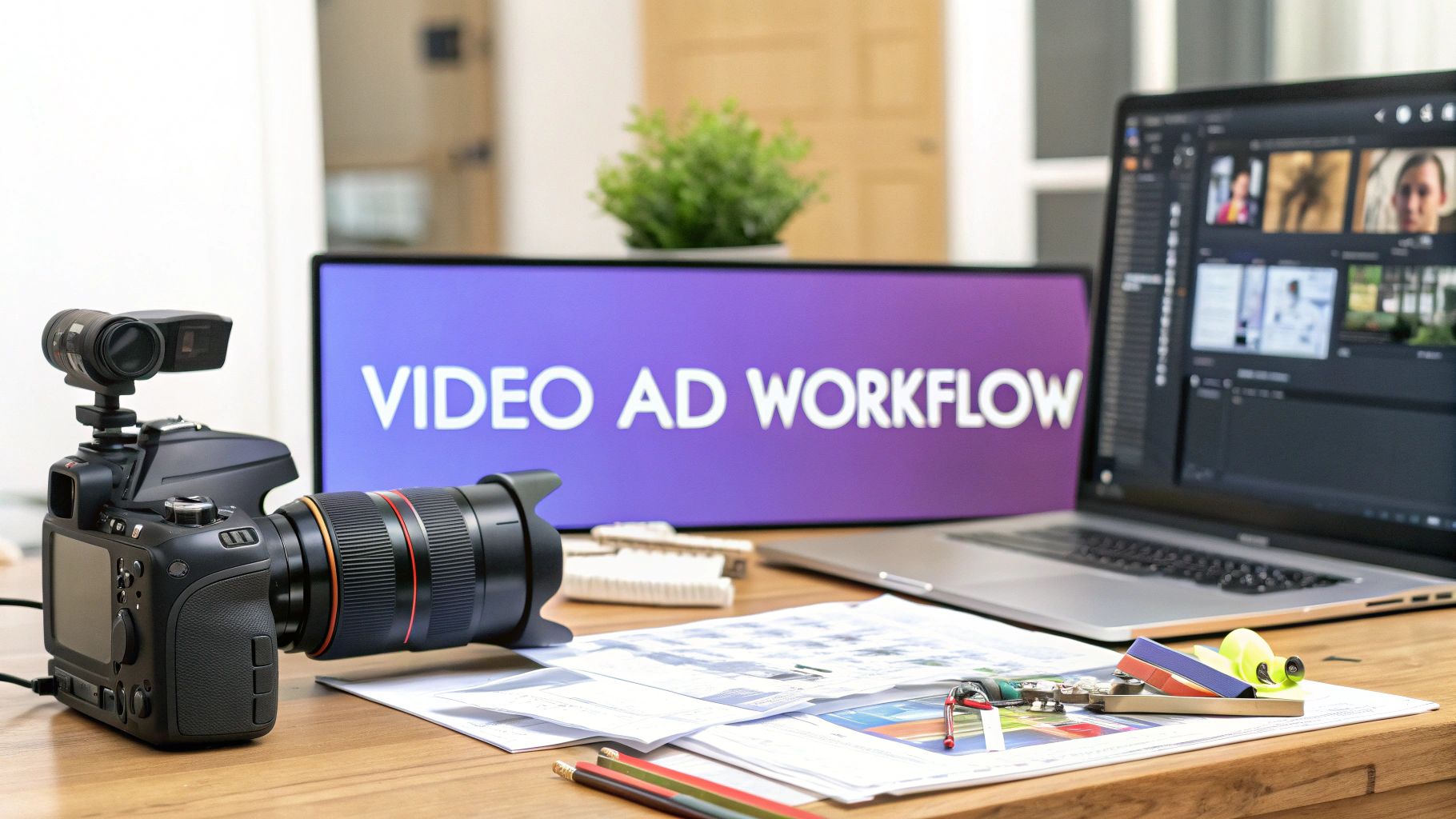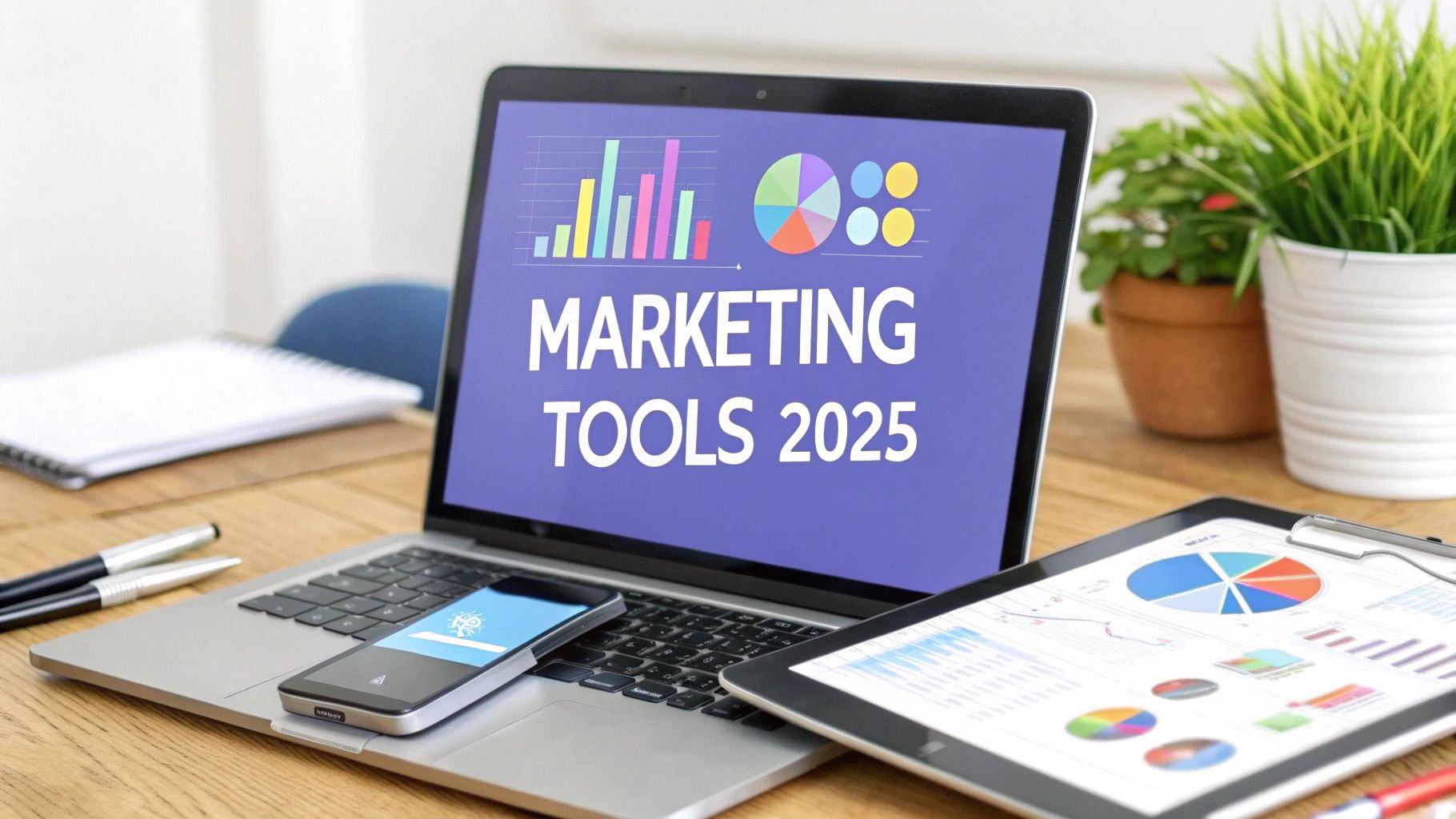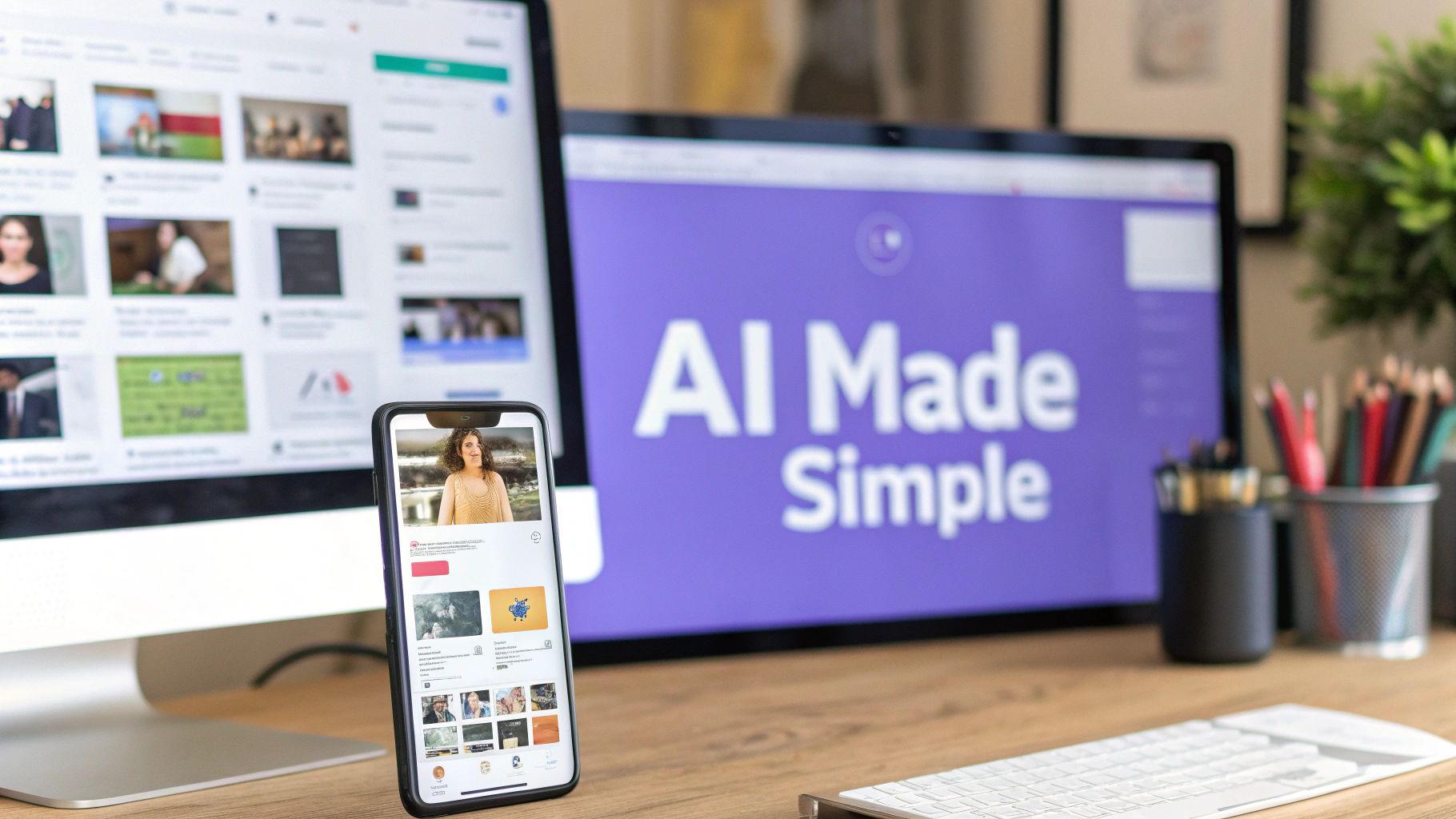I’ve seen it happen a thousand times: a team gets excited about a video ad, jumps straight to scripting, and ends up with something that looks cool but completely misses the mark. The real magic, the part that actually drives conversions, happens before you ever think about a camera.
It all starts with a rock-solid strategic foundation. You need to lock in your goal, your audience, and your core message before a single creative idea is thrown on the whiteboard. This is, without a doubt, the most critical factor in making a video ad that works.
Building the Foundation for a Winning Video Ad

Skipping this stage is like building a house without a blueprint. You might get a few walls up, but it’s destined to collapse. The most successful ads I’ve ever been a part of were the result of painstaking, deliberate choices we made right at the beginning.
This whole foundational stage really boils down to asking the right questions. What’s the one thing you need the viewer to do? Who, specifically, are you talking to? Nailing down these answers gives you the clarity you need for every single step that follows in the video ad production process.
Define Your Primary Objective
Every single ad needs one, and only one, job. If you try to build brand awareness, generate leads, and drive sales all at once, you’ll just end up with a diluted message that confuses everyone. You have to pick a single, measurable goal and stick to it.
This decision will shape everything—the tone of your ad, the call-to-action (CTA), and even how long it runs.
- Brand Awareness: Here, the goal is simply reach and recall. You want an ad that's memorable, maybe a little quirky, and gets your brand name stuck in people’s heads.
- Lead Generation: This is all about capturing contact info. Your ad has to offer a juicy incentive—a webinar, an ebook, a free trial—in exchange for that coveted email address.
- Direct Sales: This is about getting an immediate purchase. The video needs to be incredibly persuasive, create a sense of urgency, and have a crystal-clear CTA that sends people straight to a product page.
Looking at how different industries do this can be a huge help. For instance, exploring various SaaS video marketing strategies shows you how they tie specific goals to their creative approach long before they start production.
Before you move on to scripting, it's a good idea to formalize these decisions. I like to use a simple checklist to make sure all the strategic bases are covered.
Key Strategic Checkpoints for Pre-Production
| Checkpoint | Key Question to Answer | Example Goal |
|---|---|---|
| Primary Objective | What is the single most important action for the viewer to take? | Increase free trial sign-ups by 15% in Q3. |
| Target Audience | Who is the ideal person watching this ad? (Go beyond demographics) | Mid-level project managers in tech struggling with team alignment. |
| Core Message | What is the one simple idea they must remember? | Our tool eliminates unnecessary meetings. |
| Key Performance Indicator (KPI) | How will we measure success? | Cost Per Sign-Up (CPS). |
This table isn't just a formality; it's your North Star for the entire project, ensuring every creative choice serves a strategic purpose.
Get Specific About Your Target Audience
"Everyone" is not an audience. To make something that truly connects, you have to know exactly who you’re talking to. Don't just stop at basic demographics; you need to get into their heads.
What keeps them up at night? What are their biggest frustrations at work? What do they secretly wish they could achieve? A brilliant video ad speaks directly to these feelings, framing your product as the answer to a problem that’s been bugging them for months.
Key Takeaway: The more precisely you define your audience, the more your ad will feel like a one-on-one conversation instead of a generic shout into a crowd. That's where persuasion happens.
Craft Your Core Message
Okay, you have your goal and you know who you’re talking to. Now you can finally figure out what to say. Your core message is the single, simple idea you want to lodge in your viewer's brain. It has to be compelling and dead simple to understand in the first few seconds.
The ad world is unbelievably noisy, so a sharp, focused message is more critical than ever. With global ad spending projected to hit $1.15 trillion and 89% of businesses using video, you have to cut through the clutter. We know that good video content can boost conversion rates by up to 70%, which is direct proof that a well-crafted message drives real-world results. A message that’s clear, concise, and hits a nerve is what captures attention and gets people to act.
Turning Your Big Idea into a Compelling Story

Okay, you've got your strategy locked down. Now for the fun part: taking that core message and weaving it into a story that actually grabs people and holds their attention.
Let's be clear—a great story is what powers a high-converting video ad, not flashy effects or a Hollywood budget. The goal is to stop talking at your audience and start pulling them into a world where you understand their problem and your solution is the obvious hero. It all starts with a killer script.
Scripting with the Hook, Story, Offer Framework
There's no need to reinvent the wheel here. The Hook, Story, Offer (HSO) framework is an industry-standard for a reason: it just works. It's simple, powerful, and built for the lightning-fast attention spans of people scrolling through their feeds.
Here’s how it breaks down:
- The Hook (First 1-3 seconds): This is your only chance to stop the scroll. You need something visually jarring, a provocative question, or a bold claim that hits your audience's main pain point head-on.
- The Story (Next 10-20 seconds): This is the heart of your ad. You're building a connection by showing, not telling. Set up the problem, agitate it just enough to create some tension, and then introduce your solution as the game-changer.
- The Offer (Final 3-5 seconds): Your call-to-action (CTA). Make it crystal clear what you want them to do next and give them a compelling reason to do it now.
Let's imagine you're selling a project management tool. The HSO structure might look like this:
- Hook: A chaotic desk piled high with sticky notes, then a quick cut to a clean, organized workspace. Text flashes: "Is this your project plan?"
- Story: A quick-cut montage showing a team looking stressed and missing deadlines, followed by clips of them using the tool, high-fiving, and collaborating smoothly.
- Offer: A final screen with a clean "Start Your Free Trial" button and a simple text overlay: "Find Your Focus Today."
This simple flow takes the viewer on a logical and emotional journey, making your final pitch feel like a helpful next step, not a hard sell.
From Words to Pictures with Storyboarding
A script is your foundation, but it's only half the battle. Storyboarding is where you translate those words into a visual plan. It’s essentially a comic-strip version of your ad, mapping out each shot with notes on camera angles, on-screen text, and character actions.
Don't worry, you don't need to be an artist. Stick figures on post-it notes or simple shapes in a presentation slide work just fine. The real goal is to map out the visual flow and pacing before you start generating assets, which saves a ton of time and headaches later.
Expert Tip: Think in scenes and shots. A single scene in your script might need a few different shots to tell the story effectively—like a wide shot to set the scene, a close-up on a character's frustrated face, and then a shot over their shoulder showing them using your product.
This kind of detailed planning ensures your video is visually dynamic and that every single element on screen serves the story. If you really want to get this right, focus on mastering visual storytelling techniques from the get-go.
The video ad market is exploding for a reason: compelling stories get results. With video projected to make up 82% of all internet traffic, the investment is staggering—global spending is on track to blow past $190 billion. Businesses are pouring 41% to 60% of their marketing budgets into video because they see a real return, fueled by the 92% of global internet users who watch videos every month. This massive engagement is exactly why a strong, storyboarded narrative isn't a "nice-to-have"—it's a necessity.
Weaving AI into Your Production Workflow
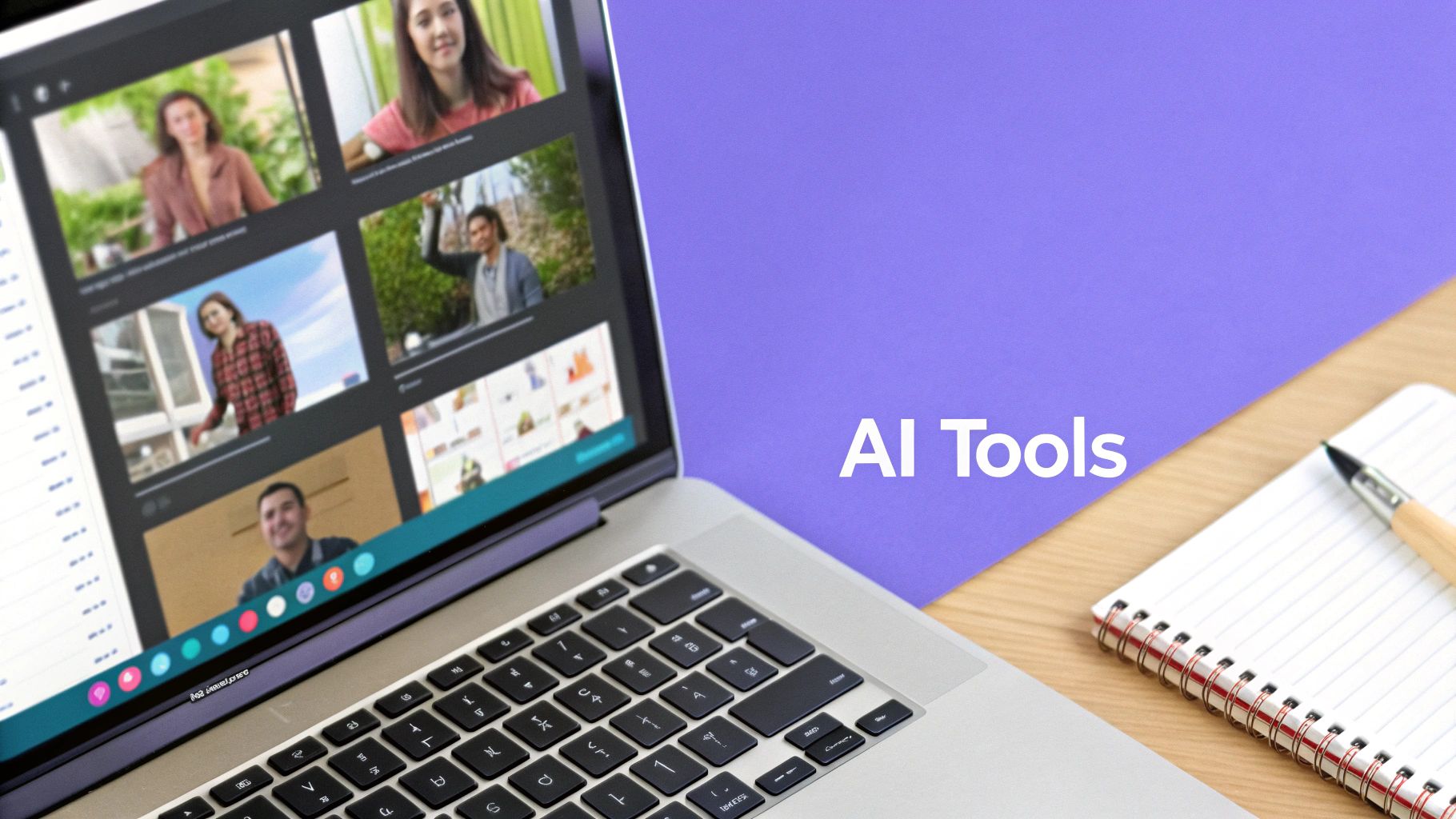
AI isn't some far-off concept in video ad production anymore—it's a real, hands-on toolkit that's changing the game. Think about it: instead of spending half a day hunting for the perfect stock clip or auditioning voice actors, you can now generate exactly what you need in minutes.
This is a massive shift. It means small teams and even solo creators can now punch way above their weight, producing ads that used to require huge budgets and a small army of specialists. It’s all about working smarter and using these incredible new tools to bring your ideas to life faster than ever.
Generating Unique Visuals from Text
One of the biggest wins with AI is creating video clips and images straight from a text prompt. This is how you finally break free from the sea of generic stock footage and start producing visuals that are perfectly dialed into your script and brand.
Let’s say your ad needs a shot of "a golden retriever wearing sunglasses skateboarding down a sunny boardwalk." Good luck finding that in a stock library. But with an AI video generator? You can create that specific, quirky, and memorable clip with a few keystrokes.
This isn't just a cool party trick; it's a strategic advantage.
- Brand Consistency: You can lock in a consistent visual style across every ad just by using similar prompts and AI models.
- Creative Freedom: The only real limit is your own imagination. You can dream up scenes that would be wildly expensive or just plain impossible to film.
- Warp-Speed Efficiency: The time you save on searching for or shooting B-roll is enormous, freeing you up to focus on what really matters: the story.
The industry is already moving fast on this. A recent report revealed that nearly 90% of advertisers are planning to use Generative AI to create their video ads. This is happening as digital video ad spending is set to skyrocket to $72 billion in the U.S. alone. This isn't just about cutting costs; it's about unlocking creative potential and scaling campaigns in ways that were previously unthinkable.
Key Insight: AI-generated visuals aren't just a stand-in for stock footage. They're a way to build a unique brand world, making your ads instantly recognizable in a crowded feed.
Creating Lifelike Voiceovers and Music
Audio is easily half the battle in a video ad, and AI has made incredible leaps here, too. You can now generate crisp, natural-sounding voiceovers in dozens of languages and accents without ever setting foot in a recording studio.
Imagine you're testing an ad for a new international market. You can generate a localized voiceover in Spanish or German in a matter of minutes. This makes it incredibly easy to A/B test different languages, tones, and styles to see what actually connects with each audience.
And it doesn't stop with voiceovers. AI can also compose custom background music for you.
- Set the Mood: Just ask for music that is "uplifting and cinematic" or "calm and ambient," and the AI will create a track that matches the emotional beats of your ad.
- Royalty-Free: Say goodbye to the headache of music licensing. The tracks are generated specifically for you, so you're clear to use them.
These tools give you total control over your ad's soundscape, ensuring every single element is working together to drive your message home. If you want a step-by-step walkthrough, check out our complete guide on how to create video ads with AI. It covers this entire process in detail.
A Practical Look at an AI-Powered Workflow
Bringing AI into your process doesn't mean you have to throw out everything you're already doing. It's about finding the right spots to inject these tools to save time, cut costs, and boost creativity.
Here’s what that might look like in practice:
- Scripting: Use an AI assistant to brainstorm a dozen different hooks or to punch up your existing script for more clarity and impact.
- Storyboarding: As you're mapping out your scenes, use an AI image generator to create "concept art" for each shot. This gives you a much better visual guide than a few stick figures.
- Asset Creation: This is the core of it. Generate your primary video clips, supporting B-roll, and any other images you need with text-to-video and text-to-image tools.
- Audio Production: Once your visuals are locked, create your voiceover and a custom music track that fits the pacing and mood you established in your storyboard.
This approach flips the traditional, slow, and linear production model on its head. It becomes a much more dynamic and iterative process. You can test ideas, generate the assets, and assemble a rough cut in a fraction of the time, leaving you with more energy to focus on strategy and optimization.
Assembling Your Ad in Post-Production
Alright, this is where the magic really happens. All your hard work in planning, scripting, and generating assets finally comes together. Post-production is the assembly line where you take all the separate parts—your footage, AI clips, voiceover, and music—and stitch them into an ad that actually converts.
A lot of creators freeze up at this stage, looking at a timeline full of clips and not knowing where to start. The trick is to stop thinking of it as one massive task. Instead, see it as a series of smaller, manageable steps. Your storyboard is your best friend here; it's the map that will guide you through building the story, shot by shot.
Laying Down the Visual Foundation
First things first, let's build the visual backbone of your ad. Drag and drop your primary video clips onto your editing timeline, following the exact sequence you laid out in your storyboard. This is what editors call a "rough cut" or an "assembly edit."
Don't get bogged down in perfecting the timing or adding slick transitions just yet. The only goal here is to see if the story flows. Does the sequence make sense? Does the visual journey from the problem to your solution feel right? This is your chance to catch any major narrative holes before you get lost in the weeds.
Once your main clips are in place, you can start weaving in your B-roll. These are the supporting shots that add flavor, context, and visual spice to your main story. For example, if your main shot is an avatar talking about a feature, your B-roll could be quick screen recordings or clips showing that feature in action.
Mastering Pacing and Rhythm
Pacing is the secret ingredient that keeps people glued to their screens. It's the rhythm of your cuts and the flow between scenes that builds energy and holds attention. Think about it: an ad with slow, long shots feels completely different from one with rapid-fire cuts. Your choice here has to serve the story you're telling.
To nail the pacing, concentrate on two simple things:
- Cut on Action: When something or someone moves, cutting right at the peak of that movement feels incredibly natural and seamless to the viewer's eye.
- Vary Your Shot Length: Mix it up. Use a combination of longer shots and short, punchy ones to create a dynamic rhythm. A flat, monotonous pace is a surefire way to get your audience to keep scrolling.
Transitions are just the bridges between your shots. And while your editing software probably offers a million flashy options, the most effective transition is often a simple, clean cut. Going overboard with spins, wipes, and dissolves can make your ad feel cheap and dated. Let the story be the star, not the special effects.
Expert Tip: Try watching your ad with the sound muted. If the story is still clear and engaging based on the visuals alone, you're on the right track. Audio should enhance the story, not carry it entirely.
Elevating Your Ad with Color and Sound
With your visual story locked in, it's time to add the emotional layers: color and sound. These two elements are what will make your ad feel polished, professional, and emotionally resonant.
Color grading isn't just about making things look pretty; it's about setting a mood. Warm tones like yellows and oranges can make an ad feel happy and energetic. Cool blues and grays can feel more serious or corporate. The key is to pick a consistent color palette that matches your brand and the feeling you want to create.
Sound design is just as important. This is a multi-layered process:
- Clean Up Your Dialogue: Make sure any voiceover or dialogue is crisp, clear, and totally free of distracting background noise.
- Choose the Right Music: Your background track should match the ad's emotional journey. It might build tension when you introduce the problem and then become more uplifting and positive when you reveal the solution.
- Add Sound Effects (SFX): Don't underestimate the power of small, subtle sound effects. A little "swoosh" when text appears or a "click" for a button press makes the whole experience feel more tangible and immersive.
Adding the Finishing Touches
The last step is to add the crucial graphic elements that tell your viewer exactly what to do. We're talking about text overlays, subtitles, and, of course, your call-to-action (CTA).
Keep any text on screen short, sweet, and easy to read. Use it to hammer home your key benefits or highlight a special offer. And since a massive percentage of social media video is watched on mute, auto-synced captions are non-negotiable. They make sure your message lands, no matter how someone is watching.
Finally, dedicate the last few seconds to a clear and powerful CTA. This could be a full-screen graphic with a button that says "Shop Now" or "Start Your Free Trial." You want to make it impossible for the viewer to miss what you want them to do next. Once all these pieces are in place, you’re ready to export.
If you're just starting out and need help picking the right tools, our guide on the best video editing software for beginners is the perfect place to start.
You've poured your heart and soul into creating the perfect video ad. Now what? The final push—the launch—is where all that hard work pays off. But a great ad can easily fall flat if it doesn't reach the right people or if it looks out of place on their screen. Getting this last part right isn't just about clicking "publish"; it's about a smart, strategic rollout.
First things first, you can't just throw the same video file everywhere. Each platform has its own rules of engagement. What looks great on YouTube will feel clunky and amateur on TikTok.
For instance, a vertical 9:16 aspect ratio is non-negotiable for platforms like Instagram Reels and TikTok. For YouTube, the classic 16:9 widescreen format still reigns supreme. Getting this simple detail wrong is an immediate red flag to viewers that you don't "get" the platform, and they'll scroll right on by.
To keep things straight, here’s a quick-reference guide for the major players.
Platform-Specific Video Ad Specifications
| Platform | Recommended Aspect Ratio | Maximum Length | Key Consideration |
|---|---|---|---|
| TikTok | 9:16 (Vertical) | 60 seconds (up to 10 min) | Sound-on is crucial. Fast-paced, native-style content wins. |
| Instagram Reels/Stories | 9:16 (Vertical) | 90 seconds (Reels), 60 seconds (Stories) | Highly visual, often with text overlays. The first 3 seconds are everything. |
| YouTube (In-stream) | 16:9 (Horizontal) | Varies (skippable after 5s) | Must grab attention before the "Skip Ad" button appears. |
| Facebook Feed | 4:5 (Vertical) or 1:1 (Square) | 240 minutes | Design for sound-off viewing; captions are a must. |
| LinkedIn Feed | 1:1 (Square) or 16:9 (Horizontal) | 30 minutes | Professional tone. Focus on value, education, or B2B solutions. |
This table is just a starting point, but it highlights how different the technical requirements can be. Always double-check the latest specs before you export your final files.
Nailing the First Impression
On platforms like YouTube, your thumbnail and title are your ad's front door. They're often the only thing standing between a scroll and a click. Don't treat them like an afterthought; they deserve as much creative attention as the video itself.
What makes a thumbnail work?
- It Pops: Think bright, contrasting colors and a clear focal point. A human face showing a strong emotion is almost always a winner.
- It’s Clear: Someone should understand the gist of your video instantly, without any confusion.
- The Text Sells: If you add text, keep it to 3-5 powerful words that spark curiosity or state a clear benefit.
Your title should work hand-in-glove with the thumbnail, asking a compelling question or making a bold promise that the viewer can't ignore.
Setting Up Your Campaign for Success
With your video files and thumbnails ready, it's time to build the campaign inside the ad platform. This is where you tell Facebook, Google, or TikTok who to show your ad to and how much you're willing to pay.
The most common mistake I see is targeting too broadly. Instead of just "small business owners," get specific. Layer your targeting with interests like "Shopify," "Klaviyo," and "digital marketing tools" for an e-commerce audience. The more you zero in on your ideal customer, the more efficient your ad spend will be.
When it comes to budget, don't go all-in from day one. Start with a modest daily spend to gather some initial data. Let it run for a few days, see what's working, and then confidently put more money behind the winners.
Tracking What Truly Matters
Your ad is live! But the job isn't done. Now, you need to watch the data like a hawk to see what's resonating and what needs tweaking. It's easy to get distracted by "vanity metrics" like raw impressions. Ignore them. Focus on the numbers that actually impact your bottom line.
This chart really drives home how much user behavior can shift from one platform to another.
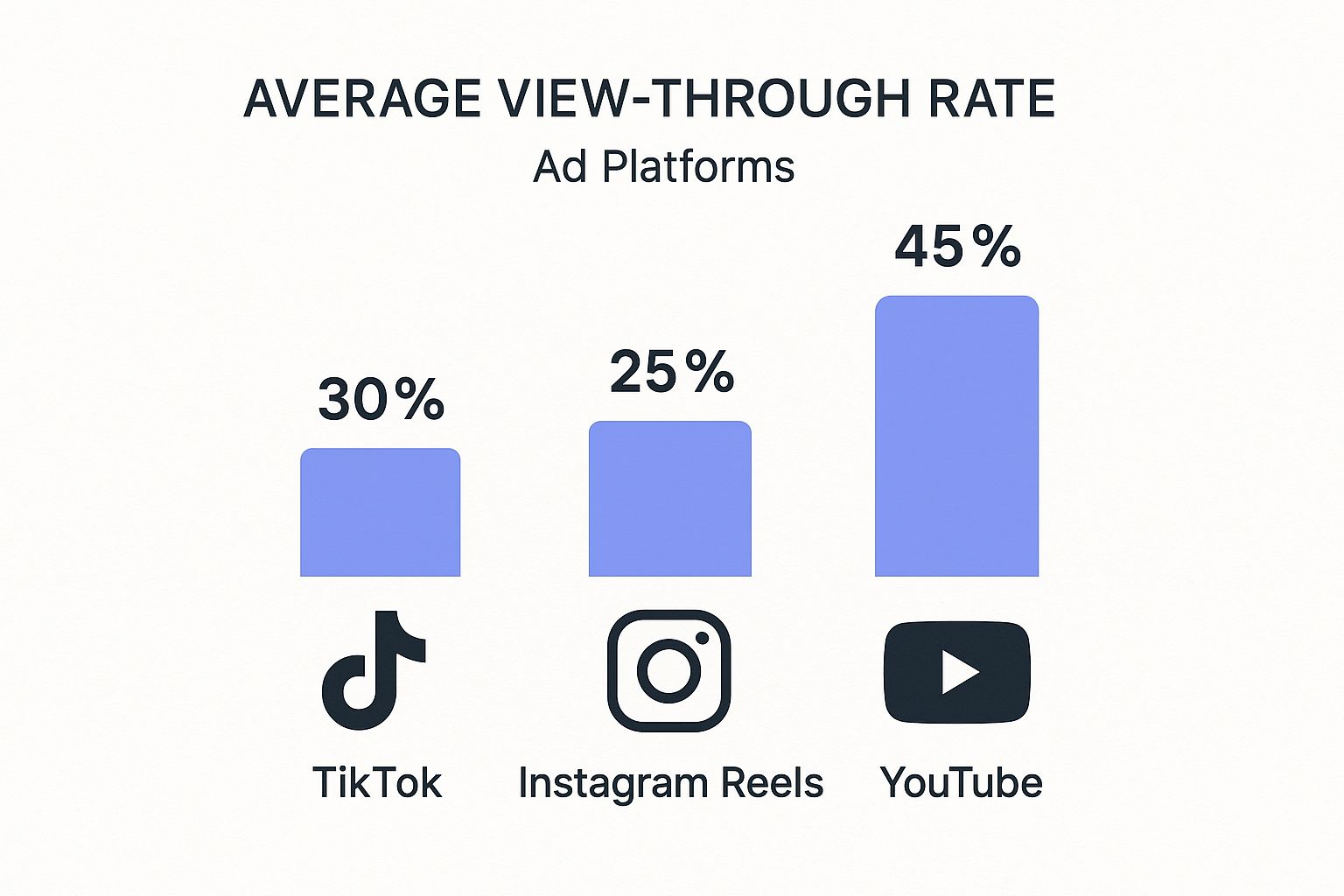
As you can see, what's considered a "good" view rate on one platform might be terrible on another. This is why a one-size-fits-all approach just doesn't work.
Key Takeaway: The goal here is relentless improvement. Use your early campaign data to form new hypotheses, then run A/B tests. Pit one hook against another. Try a different thumbnail. Test a new call-to-action. This cycle of launching, learning, and optimizing is how you transform a decent ad into a revenue-generating machine. To get more ideas on where to run your ads, check out our guide on the top video distribution platforms.
Got Questions About Making Video Ads?
Even with the best workflow, you're going to have questions. Everyone does. Getting solid answers can be the difference between a project that flows smoothly and one that feels like a constant struggle. Let's tackle some of the most common things people ask when they're getting into video ad production.
Think of this as your go-to cheat sheet. The idea is to clear up any confusion so you can get back to what matters: creating something great.
So, How Much Should I Actually Budget for This?
I wish there was a single, perfect number, but the truth is, budgets are all over the map—from a few hundred bucks to tens of thousands. For a small business just starting out, a realistic range is somewhere between $1,500 and $5,000. That's usually enough to cover everything from AI-generated assets and good stock footage to a professional voiceover.
Your budget should always tie back to your goals. Are you launching a major new product? You'll need to invest more. Just trying to get your name out there with a small brand awareness campaign? You can start leaner.
My Two Cents: Don't overthink it at the start. Begin with a budget you're comfortable with, prove your ad concept works, and then reinvest based on your results. The great thing about using modern tools is that you can scale up as you go.
What’s the Ideal Length for a Video Ad?
This one’s simple: the platform decides the length. User behavior is completely different on TikTok than it is on YouTube, so you can't just create one video and hope for the best.
Here’s a quick guide from my experience:
- TikTok & Instagram Reels: Fast and punchy is the name of the game. You're aiming for 15-30 seconds, max. People are scrolling fast, and you have to stop them in their tracks.
- YouTube Skippable Ads: You've got a little more space, but not much. Stick to that 15-30 second window. You have to make your point before that "Skip Ad" button becomes clickable.
- In-Feed Product Demos: On platforms like Facebook or even LinkedIn, you can stretch it out a bit. If you’ve got something genuinely valuable to show, you can go up to 2-3 minutes. But that first frame better be incredible.
No matter what, the first 3-5 seconds are everything. If you haven't hooked them by then, you've lost them. It's that simple.
Which Metrics Should I Actually Pay Attention To?
Don't fall into the trap of tracking every single metric. That's just noise. The "right" metrics depend entirely on what you're trying to achieve.
Focus on the key performance indicators (KPIs) that directly answer the question, "Is this working?"
- If your goal is Brand Awareness: Keep an eye on Impressions, Reach, and especially View-Through Rate (VTR). This tells you if people are actually seeing your ad and watching it.
- If you want Engagement: Look at your Click-Through Rate (CTR), shares, and comments. Are people interacting? Is the creative hitting home?
- If you need Sales or Leads: This is where it gets serious. Your world revolves around Conversion Rate, Cost Per Acquisition (CPA), and Return on Ad Spend (ROAS). These metrics tell you if your ad is actually making you money.
Ready to bring your video ad ideas to life without all the complexity? Sprello gives you an all-in-one AI suite to generate scripts, create unique visuals, and produce high-converting ads in minutes. Start creating with Sprello today.
